Real Sociedad have confirmed the signing of former RB Leipzig striker Alexander Sorloth.
The 25-year-old Norwegian joins the La Liga squad who will be looking to compete with the likes of Barcelona and Real Madrid this season.
But what exactly is he going to add to the team?
This tactical analysis will be a scout report on Sørloth, analysing what he can bring to Real Sociedad’s tactics and through further analysis, identify his strengths and weaknesses.
Alexander Sørloth Style Of Play
Having moved on Willian José to rivals Real Betis, it didn’t come as a surprise to see Real Sociedad bring in another player of a similar profile.
Standing at 6ft 4in, Sørloth is a giant of a striker, thriving on physical duels and presenting a dominant figure in the forward line.
The 25-year-old Norwegian is a good reference point up front and can be used as a target man.
His finishing is decent, albeit not elite, as the absence-ridden spell at RB Leipzig has proven for Sørloth.
Below is a statistical overview of his player profile, highlighting some of his traits well.
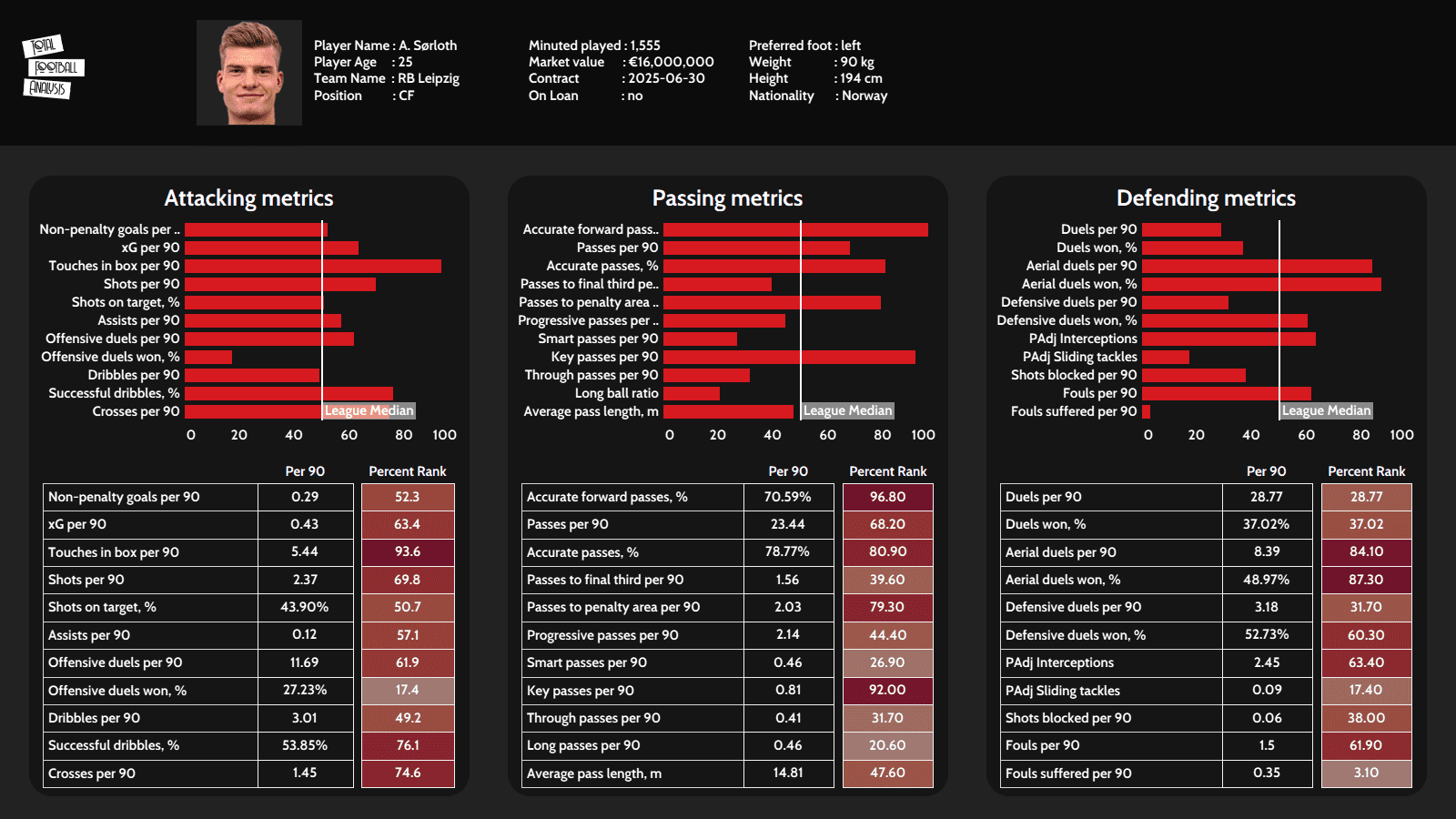
With five goals and three assists in 2020/21 (11G 3A if country included), the Norwegian’s stint in Germany left something to be desired.
He’s not a volume shooter nor is he a consistent breaker of lines through runs and movement.
Instead, Sørloth can and should be used as an outlet for progressive passing and a link-up between the thirds.
His aerial dominance, good technical ability and ball control make him a good asset in both set-pieces and transitions, meaning he suits a vast array of different tactical setups.
This could be key in diversifying Real Sociedad’s attack too.
Sørloth is also quite mobile and willing to drop deeper and drift wider should the structure demand it at the time.
This tactical analysis will now dive deeper into some of his most prominent characteristics.
Alexander Sørloth Shooting & finishing
The modern no.9 is not necessarily always judged by his goal-scoring output.
Instead, a lot more is expected from players occupying this position.
Sørloth is someone whose performance in front of goal hasn’t been too consistent.
He went from a 33 goals and 11 assists season in Turkey to five goals and three assists season in Germany, albeit with some injury problems added into the equation.
His expected goals (xG) overperformance for Trabzonspor in 2019/29 also suggested his finishing was good but there are some issues he ran into which were exposed in the last year of his football.
Below is a shot map showing us Sørloth’s last 75 attempts at goal and their outcomes, highlighting goals, shots on target and missed shots.

On the right, we can see how those attempts are spread across different zones in the final third.
There are a couple of things we have to note here too.
Sørloth is heavily left-footed and has scored the vast majority of his goals with his dominant foot and with his head, leaving only a small figure for the weaker side.
On average, Sørloth attempted 2.58 shots per 90 minutes in 2020/21, hitting the target 40.5% of the time.
That accuracy rises to 44% when we consider just the inner ring of the penalty area and falls to 33% when including attempts from outside the box and from in & around zone 14.
It’s interesting to note that a high percentage of his shots on target and goals have come after a single touch, suggesting good positioning and finishing prowess.
In fact, 10 out of his 11 goals across all competitions in 2020/21 have come after a single touch of the ball while the other one was scored after multiple touches.
Eight of them came from inside or just on the edge of the six-yard box, further two from around the penalty spot and one just outside of the box.
Sørloth is indeed a poacher as six of those 11 goals had an xG of 0.4 or above.
When it comes to his shooting technique, close-range attempts are hit with the inside of his foot, which is also how he mostly attempts to finish, while power shots and shots with his weaker foot are usually attempted with the top of the foot.
11 of his 32 shots on target have been with the inside of his foot, accounting for seven of his 11 goals scored.
And a vast majority of his attempts, especially the successful ones, come from the central corridor or from the left.
When he is forced to the right and when he has to shoot with the right, Sørloth usually takes far too many touches and ends up missing the target or getting blocked by the defender.
But that’s also where his good movement comes into play.
There are two main reasons why he gets into good positions very often.
Firstly, he moves well and exploits the defenders’ blindspot to run past them unmarked, using both pace and instinct to beat his marker.
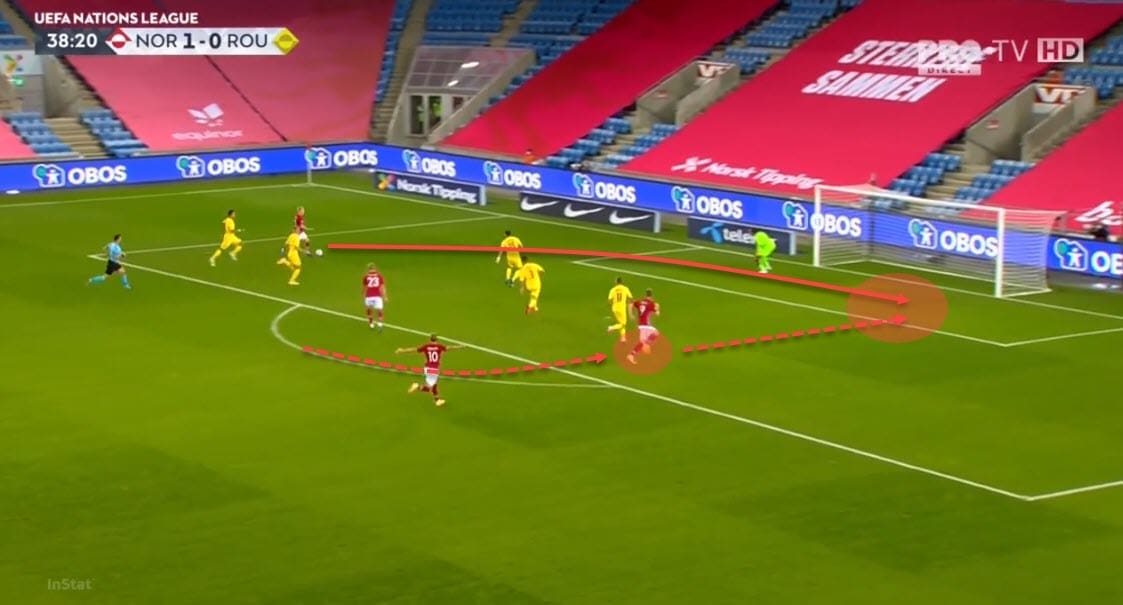
In the image above, he quickly bursts ahead of the defender from a deeper position, getting to the ball first and finishing with the tap-in with the inside of his foot.
This is how the majority of his goals are scored and also why they record such high xG values in the first place.
But there’s more to it than just being in the right spot at the right time.
Sørloth is very fast and mobile for his frame and able to manipulate his body well to quickly change directions and the speed of his movement.
The stop-and-go technique often fools defenders by leaving them flatfooted while Sørloth makes a darting run to meet a pass from his teammate.
This is usually a trait often associated with low-gravity dribblers akin to Lionel Messi or Eden Hazard but for a striker of his physique, this is more than impressive stuff from Sørloth.
Below is a great example of this technique in action.
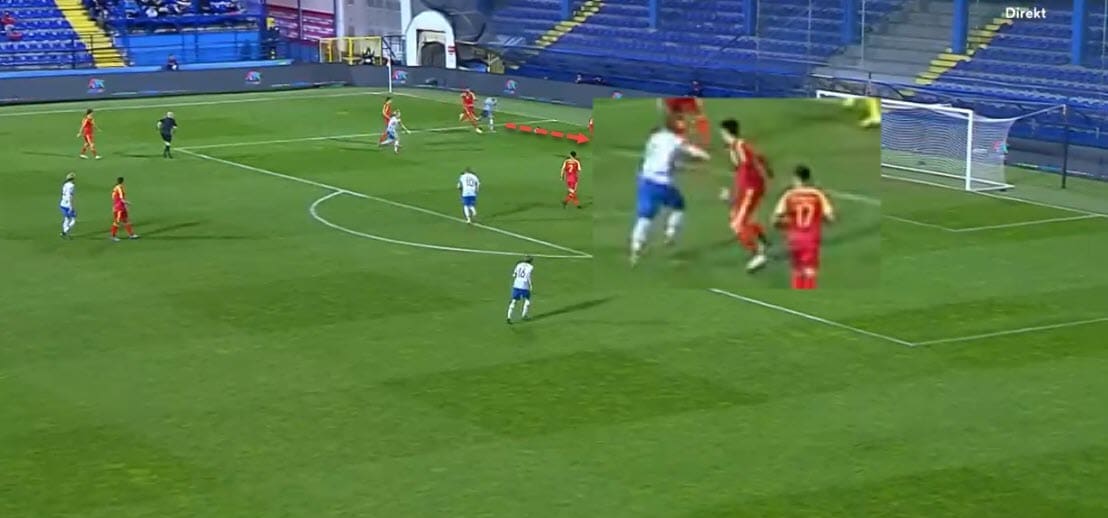
We can see Sørloth timing his burst perfectly, leaving the defender flat-footed despite being closely marked inside the area.
As soon as his teammate beats his man out wide, the Norwegian runs into the space and meets the pass for another goal attempt.
And more often than not, these high-value shots are rewarded with a rattled net.
However, it’s difficult to talk about his shooting without mentioning his aerial ability.
In 2020/21, Sørloth averaged 9.17 aerial duels per 90, winning 51%.
After all, 14 out of his 32 shots on target were headed attempts and three resulted in goals.
Quite clearly, we’re talking about a very important part of his arsenal.
So what are some of the main traits of his aerial prowess? First and foremost, the aforementioned good movement and repositioning is key to creating separation from the defender, giving him a higher chance of success.
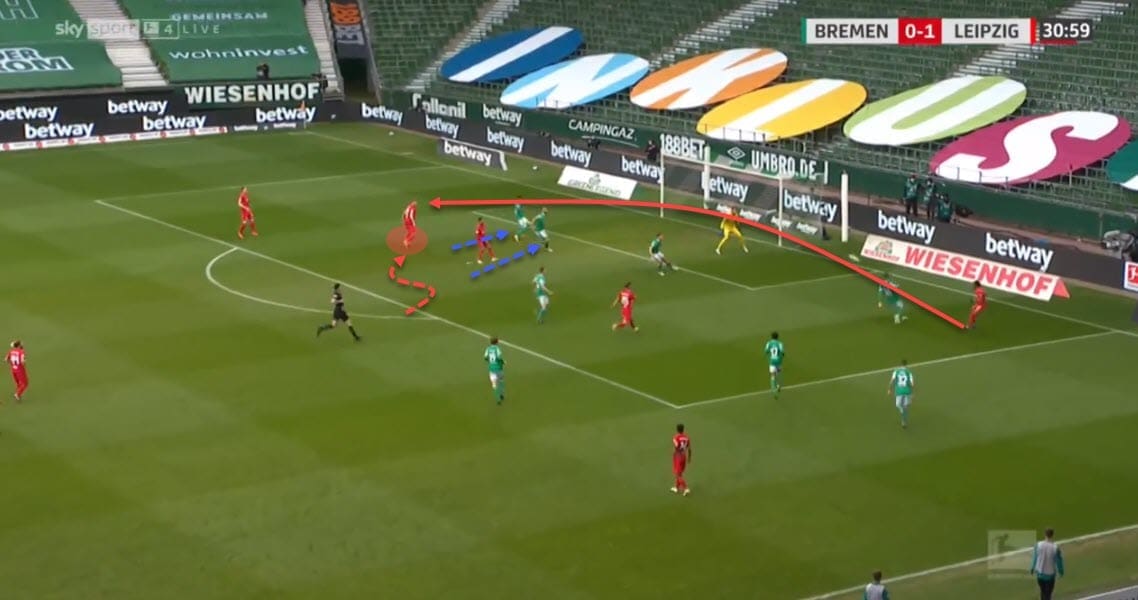
Above is a good example of this.
Sørloth charges into the box alongside his teammates but then curves his run, repositioning himself just behind the other players.
Since the two markers in red have continued their run in a straight line, Sørloth is now completely unmarked and ready to meet a cross, heading it home with enough power and precision.
This brings us nicely to the next aspect worth analysing – power.
Having enough athleticism to outjump the defenders is key and so is timing the jump well.
After analysing his headers, it does seem that he often makes use of his opponent’s errors but generally has a good sense of when to jump to get the ball.
Having excellent neck power also helps in these situations as powerful and precise headers are obviously that much more difficult to stop.
Below is a good example that doesn’t end in a goal but still helps to illustrate my point.
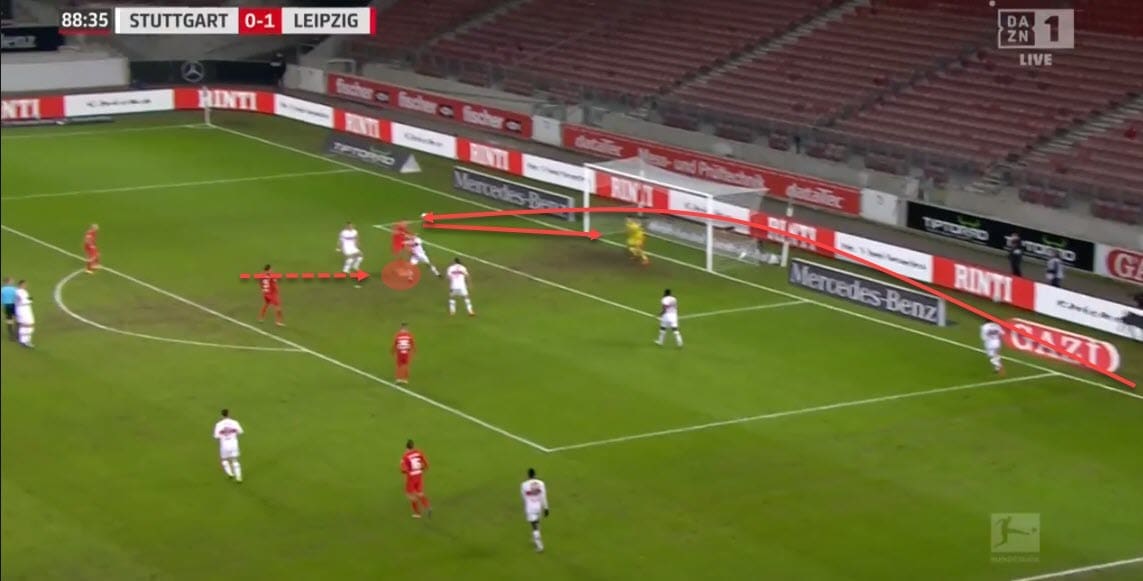
But just as was the case with his finishing on the ground, Sørloth is the type of striker who often goes for precision and placement ahead of power.
After all, only one of his goals was scored with the top of his foot while seven have come from the inside of it, preferring precision and placing the ball with a low-driven shot past the goalkeeper and between the sticks.
Alexander Sørloth Link-up play & technical quality
Despite being a very tall and physical striker, Sørloth is technically decent and can be used in link-up play as well as a lay-off option in the final third but deeper as well.
We’ve already briefly touched upon it in this scout report, but the 25-year-old is not a volume shooter and even likes to create often.
Below is his heatmap and action map, both of which can help us learn more about his tendencies on the pitch.
The high inside the box activity does speak of his poacher-like ability but we also see the map light up in the half-spaces.
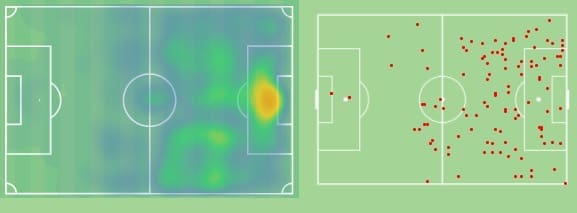
This is a direct result of Sørloth dropping deeper to receive and lay the ball off to either side, performing the role of connecting the thirds quite well.
Naturally, being left-footed, he prefers to drift towards the right side, which gives him the option to cut back in onto his dominant foot and shoot at goal or just deploy passes into his teammates.
When we take a closer look at four of his recent and random passmaps, we can see certain tendencies spring up.
Sørloth’s back-to-goal play is evident from the maps, as there’s a lot of backwards passing.
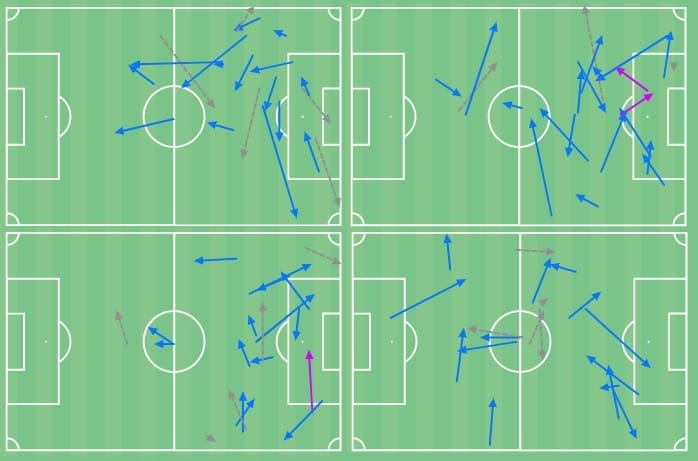
However, there are also plenty of diagonals and lay-offs, which serve the purpose of sending runners into space or just diverting play elsewhere.
He may not be much of a key passer but we can see that every now and then, especially when either receiving around zone 14 or out to the right, he can be an effective creator.
Of course, this is not his primary role nor should we expect him to demonstrate such a profile at Real Sociedad but it’s something in his locker that’s worth pointing out.
This link-up ability, however, can be used in an array of different situations.
Below, we can see Sørloth receiving the ball in the right half-space, which is something that he often does.
Drifting towards the right, as was already mentioned, is a preference for him and can be used to send runners into space.
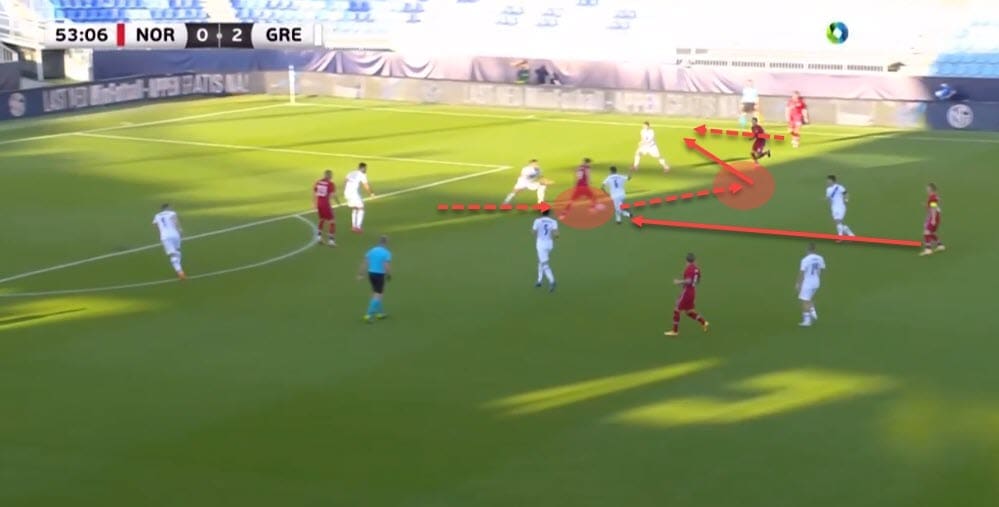
But despite not being the type of player to constantly live on the shoulder of the defender and threatening runs, Sørloth can and will combine this tendency to drop with a darting run into the box immediately after.
Often, we’ll see him drop slightly deeper to receive the ball and potentially drag his marker with him, only to use that sudden change of pace and direction to beat the defender to the ball back inside the penalty area.
Being mobile and fast enough to shake the defenders off like that and then, at the same time, showing power and technique when meeting the pass/cross in the box is very impressive.
A similar sequence can be seen in the image below.
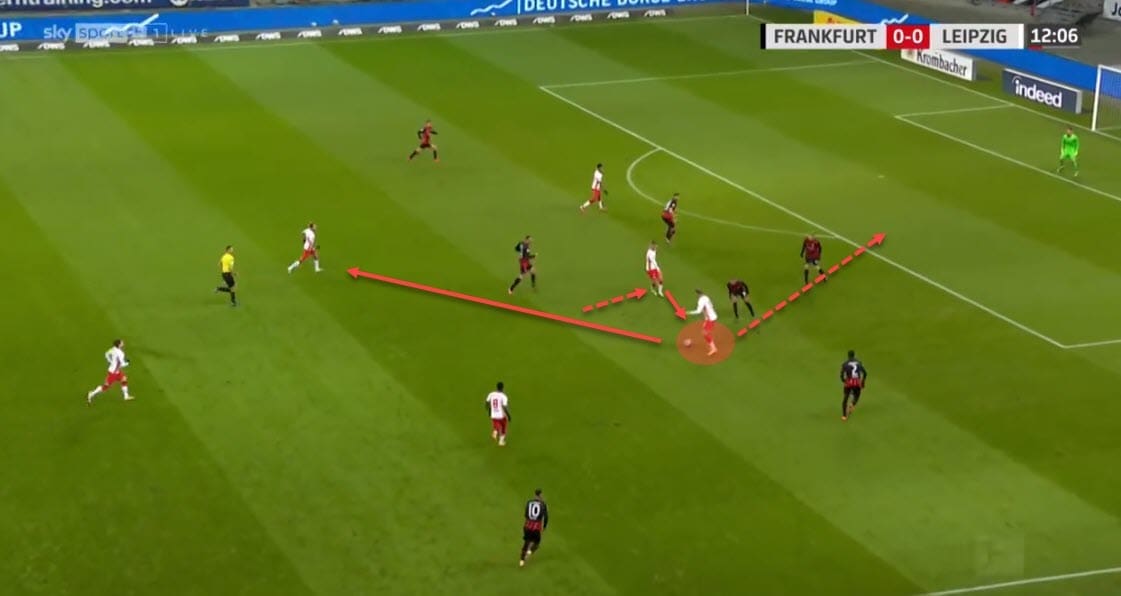
Finally, we can see from the passmap too that he sometimes likes to drop all the way to his own half to receive passes and do lay-offs.
This is mostly used to relieve pressure and help in the first phase of build-up play.
Those passes are often short and very simple, linking up with the nearest target to potentially help his team advance up the pitch more easily.
Such an example can be seen in the following image.
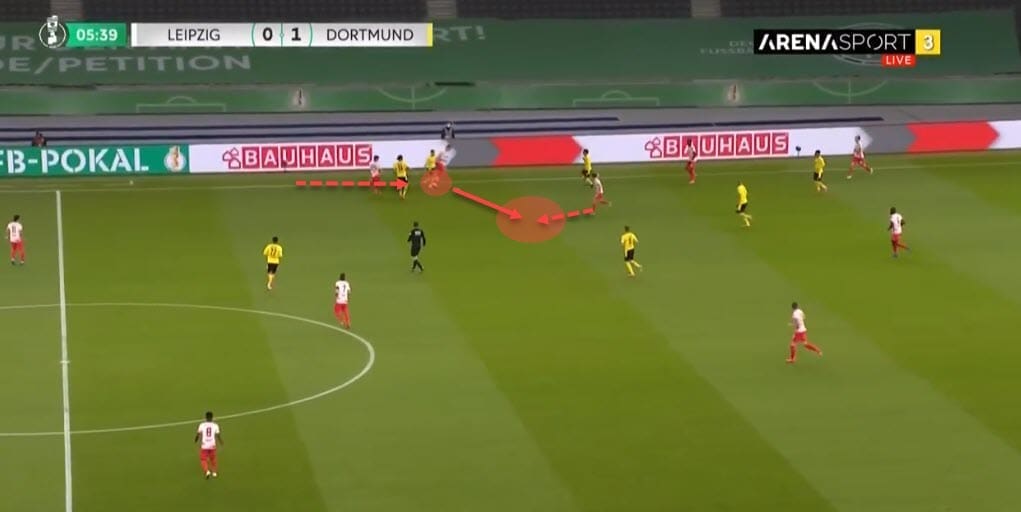
One last thing we should mention here is his dribbling ability.
While we cannot exactly talk about a highly efficient dribbler, Sørloth is still impressive, considering his frame.
Usually, once he’s drifted to the outside, he will attempt to beat his man if there are no teammates with whom he can immediately combine.
Using mainly pace when trying to get past the marker, the Norweigan can be effective in transitions and when isolated in duels.
However, this is also where most of his dispossessions happen.
Below, we can see some of his latest dribble attempts and their respective locations.
There is a clear preference for the wide areas, and that’s in line with what we’ve seen so far.
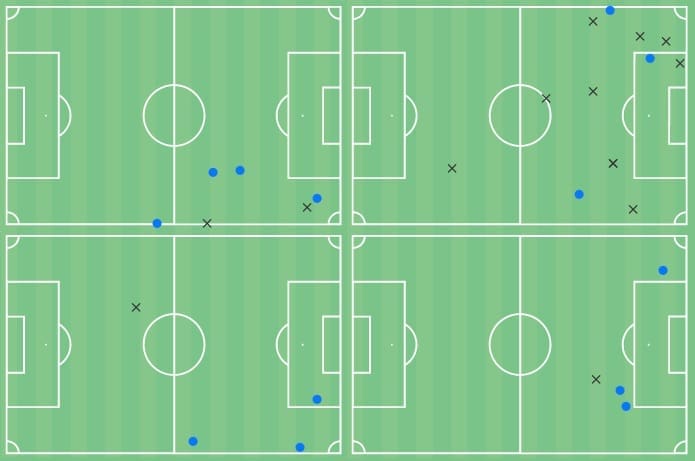
Sørloth is mobile and dynamic, especially for a target-man type of striker.
And while this may not be a highlight in his profile, it’s a welcoming addition and can be a valuable asset.
Conclusion
It may be unfair to take Sørloth’s stint in Germany as the benchmark, and the same is true for his stay in Turkey, as the level there may have been somewhat lower overall.
However, the transfer to Real Sociedad and La Liga could be a way for him to achieve redemption.
The 25-year-old could diversify La Real’s attack, giving them something different to Alexander Isak and a valid plan B.
We’ll have to wait and see whether he has enough in the tank to do more than that.






Comments